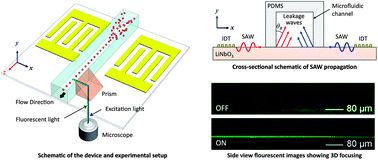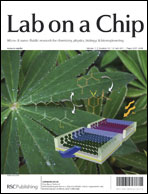Three-dimensional continuous particle focusing in a microfluidic channelvia standing surface acoustic waves (SSAW)†
Abstract
Three-dimensional (3D) continuous microparticle focusing has been achieved in a single-layer polydimethylsiloxane (PDMS) microfluidic channel using a standing surface acoustic wave (SSAW). The SSAW was generated by the interference of two identical surface acoustic waves (SAWs) created by two parallel interdigital transducers (IDTs) on a piezoelectric substrate with a microchannel precisely bonded between them. To understand the working principle of the SSAW-based 3D focusing and investigate the position of the focal point, we computed longitudinal waves, generated by the SAWs and radiated into the fluid media from opposite sides of the microchannel, and the resultant pressure and velocity fields due to the interference and reflection of the longitudinal waves. Simulation results predict the existence of a focusing point which is in good agreement with our experimental observations. Compared with other 3D focusing techniques, this method is non-invasive, robust, energy-efficient, easy to implement, and applicable to nearly all types of microparticles.


 Please wait while we load your content...
Please wait while we load your content...